Tuning of the excitation wavelength in Eu3+-aminophenyl based polyfluorinated β-diketonate complexes: a red-emitting Eu3+-complex encapsulated in a silica/polymer hybrid material excited by blue light†
Abstract
We describe herein the synthesis, characterization and photophysical properties of a series of europium complexes based on three aminophenyl based polyfluorinated β-diketonates, namely, 1-(4-aminophenyl)-4,4,5,5,5-pentafluoro-3-hydroxypent-2-en-1-one, 1-(4-(dimethylamino)phenyl)-4,4,5,5,5-pentafluoro-3-hydroxypent-2-en-1-one and 1-(4-(diphenylamino)phenyl)-4,4,5,5,5-pentafluoro-3-hydroxypent-2-en-1-one, and an ancillary ligand, 4,5-bis(diphenylphosphino)-9,9-dimethylxanthene oxide. The results demonstrated that the triphenylamine based polyfluorinated Eu3+–β-diketonate complexes dramatically red-shifted the excitation maximum to the visible region (λex, max = 400 nm) with an impressive quantum yield (40%) as compared to the simple Eu3+–aminophenyl-β-diketonate complexes (λex, max = 370 nm). This can be explained on the basis of the conjugation between nitrogen lone pair electrons and the phenyl π-electrons in the β-diketonate ligand system. On the other hand, the electron-donating dimethylamino group (Hammett constant: σp = −0.83) containing Eu3+–β-diketonate complexes moderately shifted the excitation maximum in the UV region from 370 to 380 nm as compared to unsubstituted aminophenyl (Hammett constant: σp = −0.66) Eu3+ complexes. The displacement of water molecules in aminophenyl based Eu3+–β-diketonate binary complexes by a rigid phosphine oxide ligand richly enhances the photoluminescence quantum yields as well as the excited state lifetime values of the corresponding ternary complexes. As an integral part of this work, hybrid materials have been developed through a sol–gel route by encapsulating a ternary Eu3+ compound in a silica/polymer hybrid for high performance luminescence applications. In addition, a bright red-emitting diode was fabricated by coating the designed hybrid material onto a 400 nm emitting InGaN chip and the photoluminescence was examined. Notably, the current study clearly shows that the developed triphenylamine based Eu3+–β-diketonate complex is an interesting red-emitting material excited by blue light and therefore may find potential applications in the fields of biological and materials science.


 Please wait while we load your content...
Please wait while we load your content...